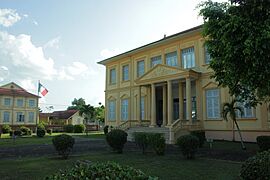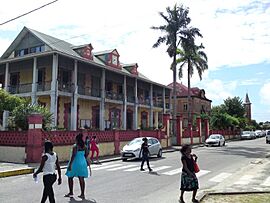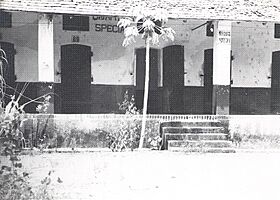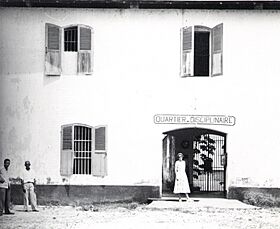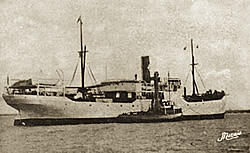Saint-Laurent-du-Maroni facts for kids
Quick facts for kids
Saint-Laurent-du-Maroni
|
||
|---|---|---|
|
Subprefecture and commune
|
||
|
From top to bottom: subprefecture building, city hall, main Catholic church of Saint-Laurent-du-Maroni
|
||
|
||

Location of the commune (in red) within French Guiana
|
||
| Country | France | |
| Overseas region and department | French Guiana | |
| Arrondissement | Saint-Laurent-du-Maroni | |
| Intercommunality | Ouest Guyanais | |
| Area
1
|
4,830 km2 (1,860 sq mi) | |
| Population
(2021)
|
50,250 | |
| • Density | 10.404/km2 (26.946/sq mi) | |
| Time zone | UTC−03:00 | |
| INSEE/Postal code |
97311 /97320
|
|
| 1 French Land Register data, which excludes lakes, ponds, glaciers > 1 km2 (0.386 sq mi or 247 acres) and river estuaries. | ||
Saint-Laurent-du-Maroni (French pronunciation: [sɛ̃ loʁɑ̃ dy maʁɔni], lit. Saint-Laurent of the Maroni; French Guianese Creole: Sen-Laurent-di-Maronni) is a commune of French Guiana, an overseas region and department of France located in South America. Saint-Laurent-du-Maroni is one of the three sub-prefectures of French Guiana and the seat of the Arrondissement of Saint-Laurent-du-Maroni. It is the second most populous city of French Guiana, with 50,250 inhabitants at the January 2021 census.
Contents
History
Founded in 1858 by Auguste Baudin, it was formerly the arrival point for prisoners, who arrived at the Camp de la Transportation.
The town was near an Amerindian settlement called Kamalakuli named after their chief. On 15 September 1880, the town became the capital city of a special prison commune; the mayor was the Director of the Penitentiary Administration.
When Gaston Monnerville was elected Deputy in 1932, he tried to close the prison complex. On 17 June 1938, the prison was repealed, but the final closure did not come until 1946. On 9 November 1949, Saint-Laurent-du-Maroni became a regular commune.
Geography
Saint-Laurent-du-Maroni is a border town in north-west French Guiana. It is located on the Maroni River (in Dutch: Marowijne), opposite the town of Albina in Suriname which can be reached by ferry or pirogue. It does not, therefore, have an Atlantic coast; this may have motivated the choice of the town's location, as the penal authorities wanted to prevent the escape of prisoners from the Prison of St-Laurent-du-Maroni by a sea route.
The ethnic composition of the town is, as everywhere in French Guiana, diverse: Maroons are today the largest ethnic group, followed by Creoles, Amerindians, Haitians, métropolitains and Brazilians.
Maroons will mostly be found in the neighbourhoods called la Charbonnière (Djukas, Saramakas and Paramaccans), les Vampires and les Sables Blancs. Amerindians are located in a few villages on the outskirts of town: Balaté (Arawaks), Paddock, Prospérité, Terre Rouge, Espérance, Village Pierre (Kalinas).
Demographics
Historical population
| Historical population Saint-Laurent-du-Maroni | |||||||||||||||||||||||||||||||||||||
|---|---|---|---|---|---|---|---|---|---|---|---|---|---|---|---|---|---|---|---|---|---|---|---|---|---|---|---|---|---|---|---|---|---|---|---|---|---|
|
|
||||||||||||||||||||||||||||||||||||
| Source: SPLAF, INSEE, Brasseur | |||||||||||||||||||||||||||||||||||||
Migrations
The places of birth of the 43,600 residents in the commune of Saint-Laurent-du-Maroni at the 2015 census were the following:
- 64.1% were born in French Guiana
- 5.3% in Metropolitan France
- 0.9% in Martinique
- 0.5% in Guadeloupe
- 0.2% in other parts of Overseas France
- 29.0% in foreign countries (notably Suriname, followed by Brazil and to a lesser extent Haiti); among these, 28.4% were immigrants and 0.7% were children of French citizens born abroad
These were the countries of birth of the immigrants living in the commune of Saint-Laurent-du-Maroni at the 2009 census:
- born in Suriname: 7,631
- born in Brazil: 3,105
- born in Haiti: 1,199
- born in Guyana: 327
- born in other countries: 530
Environment
This river town has long been the headquarters of an important association for the protection of the environment: "Le pou d'agouti" (an environmental organisation named after an annoying local mite with an itchy bite which strives for the protection of local and regional fauna and flora.
It is also the point of departure for several ecotourism circuits, most notably journeys upriver to explore the many creeks as well as the Amazonian rainforest; tourists can spend a night in the jungle in huts or tents. Another possibility is visiting the Voltaire Falls, situated 70 km (43 mi) upriver.
Industrial activities, slowly increasing urban density and its accompanying shanty towns as well as poaching have damaged the surrounding area, but on 23 May 2009, a species of Caecilian theretofore unknown to man was discovered in town.
Transport
Between 1890 and 1897, a 16 kilometre Decauville railway was constructed between Saint-Laurent-du Maroni and Saint-Jean-du-Maroni. Another 22 kilometre railway was built to the sawmill at Charvein. The railways were abandoned after the penal camps closed.
Saint-Laurent-du-Maroni can be accessed chiefly by road, the Route Nationale 1, from Cayenne. A new port was recently built on the Maroni, but currently lacks proper wharf infrastructure and sufficient river depth. The Saint-Maurice airfield was decommissioned in 1946, but is used for sports. The Saint-Jean road links Saint-Laurent to Saint-Jean-du-Maroni and the military base there.
In 2010, Route Nationale opened connecting Saint-Laurent-du-Maroni starting from the Plateau des Mines to Apatou. The road was opened with the Tour of Guiana. The road is scheduled to be extended to Maripasoula. Construction work on the section between Apatou and Papaïchton is planned to commence in 2021.
The town is also an important port of departure for those going inland via pirogue or to Albina in Suriname by ferry or pirogue.
The town's Saint-Laurent-du-Maroni Airport is served by Air Guyane Express.
Economy
The sugarcane fields near town produce "La Belle Cabresse" rum (as well as the less well-known "La Cayennaise" and "Cœur de Chauffe") for the Saint Maurice rum company. The rum is 50 to 55% proof and of high quality.
On the road to Saint-Jean-du-Maroni (about 17 km (11 mi) south of St-Laurent, home of the former penal Camp de la Rélégation), one can find many small shops owned by Saramakas selling the woodwork for which they are famous - especially chairs and tables. There is also a village of Maroon artisans on the road to Javouhey.
Two military units are stationed at St-Jean's Camp Némo: the Groupement du service militaire adapté (GSMA), which is part of the Ministry of Overseas France and is in charge of professional job reinsertion in the west of French Guiana; and the Maroni detachment of the 9th Marine Infantry Regiment whose job it is to patrol the river border and the jungles of the west of the département.In 2008, the two units has merged into the Regiment of the Adapted Military Service (RSMA).
Sights
Originally built by, and for, the French department of corrections or Administration Pénitentiaire, many old official buildings in Saint-Laurent-du-Maroni bear a distinctive architectural style, a unique mix of colonial style and penitentiary architecture. Bricks made from the local red clay were used by the convicts, who provided a free and never-ending workforce, to build a whole official and administrative district, starting with the main jailhouse itself, the Camp de la Transportation.
Some of the main buildings in the old administrative district, locally called Le Petit Paris for its alleged reminiscence of a 19th-century French architecture:
- Le Camp de la Transportation (guided tours available, famous for Henri 'Papillon' Charrière's cell) and the adjacent Office du Tourisme;
- La Résidence du Gouverneur du bagne, today's residence of the sous-préfet, and formerly the governor's residence;
- Le Tribunal maritime, today's sous-préfecture;
- La Mairie (city hall) and the former bank;
- St. Lawrence Church;
- Le Trésor public;
- L'Hôtel La Tentiaire;
- La caserne Joffre (the Gendarmerie HQ);
- André-Bouron Hospital (It was in use until September 2018).
Most of these buildings are located on Avenue De Gaulle, Avenue Lieutenant-Colonel Tourtet and the Boulevard Mallouet. After the jailhouse was closed and the penal authority left in the early 1950s, these buildings suffered from lack of maintenance and interest, and were much damaged due to the harsh weather conditions in western French Guiana. Close to a state of total ruin, they underwent a major restoration in the early 80s, after the city council and French Minister of Culture realized that the old penitentiary and administrative district was of high cultural and historical interest. It soon became a major tourist attraction, with the Camp de la Transportation its star.
Other notable sights from the penitentiary years include Saint-Jean-du-Maroni, formerly the Camp de la Relégation and today's main military HQ for western French Guiana. There is also a small island in the middle of the Maroni River which used to house the prisoners affected with leprosy. Papillon wrote about hiding there during one of his daring escapes.
Notable sights not related to the prisons:
- La Charbonnière: Maroon village founded by refugees from Suriname's civil war.
There are many hotels in Saint-Laurent-du-Maroni, including the Auberge Bois Diable, Chez Julienne, Hôtel la Tentiaire, Le Relais des 3 Lacs and Star Hôtel.
Climate
Saint-Laurent-du-Maroni features an equatorial climate that is a tropical rainforest climate (Köppen Af) more subject to the Intertropical Convergence Zone than the trade winds and with no cyclones. The temperatures are uniform throughout the year, with the average annual low being around 24 °C (75 °F) and the average annual high being around 29 °C (84 °F), although September and October, the driest two months, have a slightly higher average high at 31 °C (88 °F). The town receives an abundant amount of rain throughout the year, classifying it as a tropical rainforest climate as all months have at least 100 mm (3.9 in) of rain per month, unlike the south and east of French Guiana where the months of September and October are typically drier than this. On 27 September 2016, Saint-Laurent-du-Maroni recorded a temperature of 38.0 °C (100.4 °F), which is the highest temperature to have ever been recorded in the French Guiana.
| Climate data for Saint-Laurent-du-Maroni | |||||||||||||
|---|---|---|---|---|---|---|---|---|---|---|---|---|---|
| Month | Jan | Feb | Mar | Apr | May | Jun | Jul | Aug | Sep | Oct | Nov | Dec | Year |
| Mean daily maximum °C (°F) | 28 (82) |
28 (82) |
28 (83) |
28 (83) |
28 (83) |
28 (83) |
29 (84) |
30 (86) |
31 (87) |
31 (87) |
29 (85) |
28 (83) |
29 (84) |
| Mean daily minimum °C (°F) | 24 (75) |
24 (75) |
24 (76) |
24 (76) |
24 (76) |
24 (75) |
24 (75) |
24 (76) |
24 (76) |
24 (76) |
24 (75) |
24 (75) |
24 (75) |
| Average rainfall mm (inches) | 260 (10.3) |
180 (7.1) |
190 (7.6) |
240 (9.5) |
350 (13.6) |
330 (13) |
250 (9.7) |
170 (6.8) |
110 (4.5) |
100 (4) |
160 (6.3) |
250 (9.7) |
2,590 (102.1) |
| Source: Weatherbase | |||||||||||||
Notable people
- Lénaïck Adam (1992), politician.
- Léon Bertrand (1951), politician and mayor.
- Raoul Diagne (1910–2002), footballer.
- Sonia Francius (born 1979), civil servant.
- Oriane Jean-François (2001), footballer.
- Florian Jozefzoon (1991), footballer.
- Stéphane Martine (1978), footballer.
- Raymond Tarcy (1936–2019), politician and senator.
Villages
- Balaté, an Lokono village near Saint-Laurent-du-Maroni
- Espérance, a Kalina village near Saint-Laurent-du-Maroni
- Île Portal, an island in the Maroni River
- Saint-Jean-du-Maroni, a village in the commune of Saint-Laurent-du-Maroni


